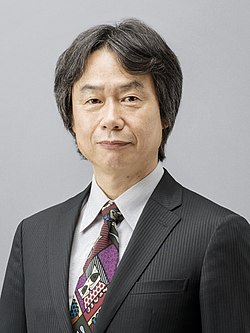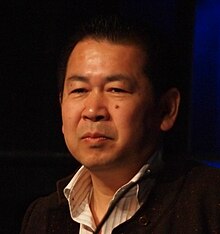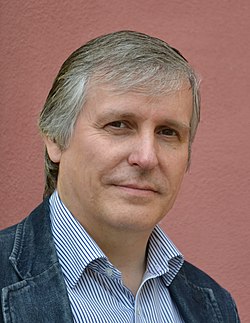Portal:Video games
The Video Games Portal

A video game or computer game is an electronic game that involves interaction with a user interface or input device (such as a joystick, controller, keyboard, or motion sensing device) to generate visual feedback from a display device, most commonly shown in a video format on a television set, computer monitor, flat-panel display or touchscreen on handheld devices, or a virtual reality headset. Most modern video games are audiovisual, with audio complement delivered through speakers or headphones, and sometimes also with other types of sensory feedback (e.g., haptic technology that provides tactile sensations). Some video games also allow microphone and webcam inputs for in-game chatting and livestreaming.
Video games are typically categorized according to their hardware platform, which traditionally includes arcade video games, console games, and computer games (which includes LAN games, online games, and browser games). More recently, the video game industry has expanded onto mobile gaming through mobile devices (such as smartphones and tablet computers), virtual and augmented reality systems, and remote cloud gaming. Video games are also classified into a wide range of genres based on their style of gameplay and target audience. (Full article...)
Featured articles –
Set in the fictional Star Wars galaxy, the game takes place during the events depicted in the film Star Wars: Episode I – The Phantom Menace. The player controls Gavyn Sykes, a lieutenant in Naboo's Royal Security Forces. As the game progresses, Sykes and the Royal Security Forces fight the Trade Federation in 15 missions that take place on Naboo or in the space surrounding it. The game concludes after the player completes a mission that recreates the film's climactic assault on the Trade Federation's Droid Control Ship.
Battle for Naboo was published by LucasArts and THQ and released for the Nintendo 64 in December 2000. A Windows port was released three months later in March 2001. The Nintendo 64 version was heavily compared to Rogue Squadron and received generally positive reviews; critics praised the game's tight and responsive controls, but expressed dislike for the game's Episode I setting. The game's PC port was less well-received, with critics citing poor visuals and difficult controls. (Full article...)
The name Alleyway references the in-game gateway that the player's spaceship (represented as a paddle) must pass through. While Alleyway is a portable clone of Breakout, it adds several features, including alternating stages, bonus rounds, and hazards for the player at later levels. While the game's original box art featured an unidentifiable protagonist, later international releases of the game replaced the character with Mario. Alleyway was released with limited advertising, receiving moderate to low scores from reviewers who compared it to games like Arkanoid. (Full article...)
The Lost Levels is similar to Super Mario Bros, with players controlling Mario or Luigi to rescue Princess Peach from Bowser. It adds a greater level of difficulty and Luigi controls slightly differently from Mario, with reduced ground friction and increased jump height. The Lost Levels also introduces obstacles such as poison mushroom power-ups, counterproductive level warps, and mid-air wind gusts. It has 32 levels across eight worlds and 20 bonus levels.
Reviewers viewed The Lost Levels as an extension of Super Mario Bros, especially its difficulty progression. Journalists appreciated the challenge when spectating speedruns and recognized the game as a precursor to the franchise's Kaizo subculture in which fans create and share ROM hacks featuring nearly impossible levels. This sequel gave Luigi his first character traits and introduced the poison mushroom item, which has since been used throughout the Mario franchise. The Lost Levels was the most popular game on the Disk System, for which it sold about 2.5 million copies. It is remembered among the most difficult Nintendo games. (Full article...)
In the story, protagonist Neku Sakuraba and his allies are forced to participate in a game that will determine their fate. The battle system uses many of the unique features of the Nintendo DS, including combat that takes place on both screens, and attacks performed by certain motions on the touchscreen or by shouting into the microphone. Elements of Japanese youth culture, such as fashion, food, and cell phones, are key aspects of the missions and character progression.
The World Ends with You received critical acclaim upon release, with critics praising the graphics, soundtrack, and integration of gameplay into the Shibuya setting, with minor criticism directed at its learning curve and occasionally imprecise touch-screen controls. It is regarded as one of the best Nintendo DS games, and one of the greatest video games ever made. In the first week of its release, the game was the second best-selling DS title in Japan, and the top-selling DS title in North America. Shiro Amano, writer and artist of the Kingdom Hearts manga, later created a manga based on the video game. An anime adaptation by Square Enix, DOMERICA, and Shin-Ei Animation aired from April 10 to June 26, 2021. (Full article...)
Bungie initially conceived ODST as a small side project to produce in the lull between Halo 3's completion and Halo: Reach. Instead of featuring recognizable characters such as armored protagonist Master Chief, the developers focused on the ODSTs. Story director Joseph Staten penned a detective story utilizing film noir designs, settings, and characters. Composer Martin O'Donnell abandoned his previous Halo themes to create a quieter, jazz-influenced sound. During development, the planned expansion grew in scope to that of a full-sized game. Release marketing for the game included a tie-in comic, live-action trailers, and print and web advertisements.
Upon release, ODST became the top-selling Xbox 360 game worldwide. The title received generally positive reviews from critics, who praised the atmosphere, music, and story approach. Reviewers were divided on whether the relatively short campaign and included extras were enough to justify the game's US$60 price tag. The game was the top-selling title in the United States in September 2009, and sold more than 3 million copies worldwide. Softpedia, Time, and Wired were among publications that declared the game one of the year's best. The single-player campaign was re-released as downloadable content for the Halo: The Master Chief Collection for Xbox One in May 2015 and was released on PC, also as part of The Master Chief Collection, on September 22, 2020. (Full article...)
Power Tennis incorporates multiple characters, themes, and locations from the Mario series. The game includes standard tennis matches, but contains variants that feature different scoring formats and objectives. Other variants include "Gimmick" courts, thematic areas with components and properties that directly affect gameplay. The game has 18 playable characters, each categorised by their style of play and each with a pair of unique moves known as "Power Shots". Power Tennis was developed simultaneously with Mario Golf: Toadstool Tour, and the pair shared similar technology and concepts with each other during production. Such similarities include an emphasis on the Mario theme in characters and settings as well as alternative game modes such as "Ring Shot".
The GameCube version was positively received in general, attaining an aggregate score of 81 percent from GameRankings and 80 out of 100 from Metacritic. Critics praised the game's depth and variety, but criticised the Power Shot animations, which could not be skipped. The Wii version in contrast received a more mixed reaction, with praise for the graphics and multiplayer but criticism for its motion controls. In 2010, it was included as one of the games in the book 1001 Video Games You Must Play Before You Die. (Full article...)
Like most installments in the Mario Party series, Mario Party DS features characters from the Mario franchise competing in a board game with a variety of minigames, many of which utilize the console's unique features. Up to four human players can compete at a time, though characters can also be computer-controlled. The game features a single-player story mode as well as several other game modes.
Mario Party DS received mixed reviews, with general praise for its minigame variety and criticism for its absence of an online multiplayer mode. The game has sold more than nine million units worldwide, making it the 11th-best-selling game for the Nintendo DS. Mario Party DS was succeeded by Mario Party 9 for the Wii in 2012. (Full article...)
Born in Sapporo, Iwata expressed interest in video games from an early age and created his first simple game while in high school. He majored in computer science at the Tokyo Institute of Technology. In 1980, he joined the game developer HAL Laboratory while attending the university. At HAL, he worked as a programmer and closely collaborated with Nintendo, producing his first commercial game in 1983. Games to which he contributed include EarthBound and many games in the Kirby series. Following a downturn and near-bankruptcy, Iwata became the president of HAL in 1993 at the insistence of Nintendo president Hiroshi Yamauchi and brought financial stability. In the following years, he worked in the development of the Pokémon and Super Smash Bros. series. Iwata joined Nintendo as the head of its corporate planning division in 2000.
Nintendo saw growth under Iwata and, when Yamauchi retired, he became the company's president in May 2002. Under Iwata's direction, Nintendo developed the Nintendo DS and Wii game consoles, helping the company achieve financial success. As a self-declared gamer, he focused on expanding the appeal of video games across demographics through a "blue ocean" business strategy. Nintendo attained record profits by 2009, and Barron's placed Iwata among the top 30 CEOs worldwide. Iwata expanded his strategy by defining a quality-of-life product line for the Wii that evolved into a ten-year strategy to create standalone products. Later hardware such as the Nintendo 3DS and Wii U proved far less profitable than the Wii, and Nintendo's net sales fell by two thirds from 2009 to 2012; the company saw its first operating losses in 30 years during this time. Iwata voluntarily halved his salary in 2011 and again in 2014. In 2015, after several years of refusal, Iwata put a portion of Nintendo's focus into the rapidly growing mobile game market; a landmark partnership with mobile provider DeNA was established that March. Throughout his career, Iwata built a relationship with Nintendo fans through social media and his regular appearances in Iwata Asks and Nintendo Direct, becoming the public face of the company. (Full article...)
The Sega Saturn is a home video game console developed by Sega and released on November 22, 1994, in Japan, May 11, 1995, in North America, and July 8, 1995, in Europe. Part of the fifth generation of video game consoles, it is the successor to the successful Genesis. The Saturn has a dual-CPU architecture and eight processors. Its games are in CD-ROM format, including several ports of arcade games and original games.
Development of the Saturn began in 1992, the same year Sega's groundbreaking 3D Model 1 arcade hardware debuted. The Saturn was designed around a new CPU from the Japanese electronics company Hitachi. Another video display processor was added in early 1994 to better compete with the 3D graphics of Sony's forthcoming PlayStation.
The Saturn was initially successful in Japan but not in the United States, where it was hindered by a surprise May 1995 launch, four months before its scheduled release date. After the debut of the Nintendo 64 in late 1996, the Saturn rapidly lost market share in the US, where it was discontinued in 1998. The Saturn is considered a commercial failure; this was affected by the cancellation of Sonic X-treme, planned as the first 3D entry in Sega's popular Sonic the Hedgehog series. The Saturn was succeeded in 1998 by the Dreamcast, having sold 9.26 million units sold worldwide, most in Japan. (Full article...)
Did you know... -
- ... that the leak of the upcoming Grand Theft Auto game was described as one of the biggest leaks in video game history?
- ... that the 1979 video game Superman was one of the first console games with a pause feature?
- ... that Goodboy Galaxy was the first commercially released video game for the Game Boy Advance in more than 13 years?
- ... that after becoming paralyzed from the neck down, Rocky "RockyNoHands" Stoutenburgh broke two Guinness World Records in the video game Fortnite?
- ... that the contrabass trombone has experienced a revival in film music and video game soundtracks?
- ... that for at least 90 minutes, Mori Calliope livestreamed herself begging video game developer Atlus to allow her to stream their game Persona 3?
- ... that Cybermania '94 was the first televised video game awards show?
- ... that a pink skin for Mercy in the video game Overwatch helped raise more than $12 million for breast cancer research?
- ... that classified documents of the United States were partially leaked onto a Discord server for the video game Minecraft?
- ... that the video game Serious Sam: Tormental was originally inspired by Geometry Wars?
- ... that the 1992 video game Otogirisō reinvigorated interest in adventure games in Japan?
- ... that the science-fiction video game The Anacrusis is named after a musical term?
Selected biography –
Selected image -
Recent video game-related events
- April 4, 2025 – Tariffs in the second Trump administration
- Multiple companies, including Klarna, StubHub, Nintendo, and Professional Sports Authenticator, pause price-sensitive business actions in the U.S. to evaluate the impact of the recent tariff announcements. (The Wall Street Journal) (IGN) (The Verge)
- January 16, 2025 –
- Nintendo officially reveals the Nintendo Switch 2 video game console, the successor to the Nintendo Switch. (Nintendo)
- September 12, 2024 – 2023–2024 video game industry layoffs
- Microsoft announces that it will lay off 650 Microsoft Gaming employees as part of cuts to its workforce. (Variety)
Topics
Categories
Things you can do
In other Wikimedia projects
The following Wikimedia Foundation sister projects provide more on this subject:
-
Commons
Free media repository -
Wikibooks
Free textbooks and manuals -
Wikidata
Free knowledge base -
Wikinews
Free-content news -
Wikiquote
Collection of quotations -
Wikisource
Free-content library -
Wikiversity
Free learning tools -
Wiktionary
Dictionary and thesaurus

















































